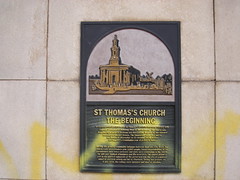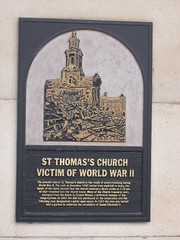Commemorated on 2 plaques
St Thomas's Church the beginning. A contemporary illustration of St Thomas's shows an imposing building with Chipman's windmill at Holloway Head in the distance. The church was designed by architects Rickman and Hutchinson, inspired by the classical buildings of ancient Greece. The foundation stone was laid by the Bishop of Worcester on 22 October 1829. It cost His Majesty's Commission pver £14,000 to build. Serving the growing community between Holloway Head and Five Ways, the church could accommodate over 2,000 people. Social responsibilities to its parishioners were taken seriously and clubs were established in the 1830s for sick pay, medical attendance and life assurance. The church played a part in the political upheavals of the period and was the site of a protest aimed at electoral reform and led by Chartists. During the protest, on 4 July 1839, the railings were uprooted and used as missiles.
The Peace Garden, Granville Street, Birmingham, United Kingdom where it sited (1829-1940)
St Thomas's Church victim of World War II. The present ruin of St Thomas's Church is the result of severe bombing during World War II. The raid, in December 1940 lasted from nightfall to dawn, the hands of the clock showed that the church received a direct strike at 7.25pm. All that remained was the church tower. Many of the Church treasures were salvaged from the debris by Ernest Mason, a dedicated member of the congregation. In 1941 the site was purchased by the corporation and the following year designated a public open space. In 1953 the area was turned into a garden to celebrate the coronation of Queen Elizabeth II.
The Peace Garden, Granville Street, Birmingham, United Kingdom where it was bombed (1940)

